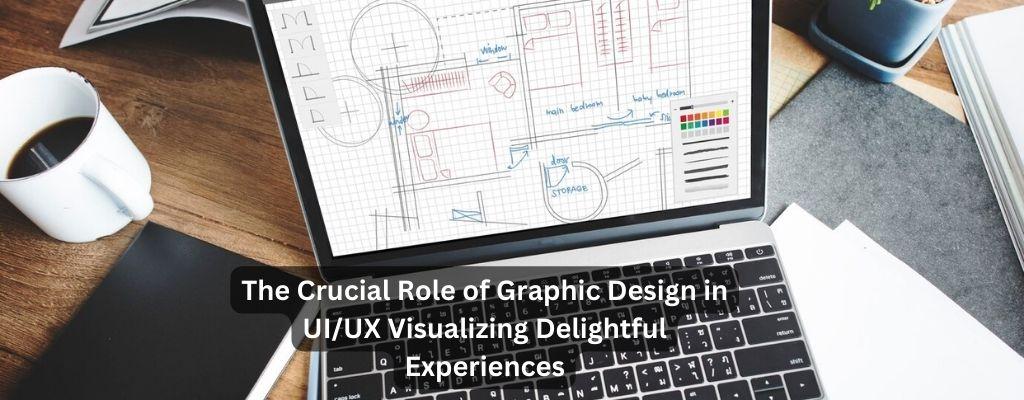
Graphic design in UI/UX plays a pivotal role in creating visually engaging and user-friendly interfaces that enhance the overall user experience. User Interface (UI) and User Experience (UX) design are fields that have evolved significantly in recent years, becoming crucial components of digital product development. A successful UI/UX design not only ensures functionality but also strives to provide users with delightful and seamless experiences. In this pursuit, graphic design plays a pivotal role. Graphics, encompassing elements such as images, icons, typography, colors, and layout, are the visual storytellers that transform a utilitarian interface into an engaging and memorable journey for the user. This article explores the essential role of graphic design in UI/UX and how it contributes to visualizing delightful experiences.
Table of Contents
ToggleIntroduction
The primary objective of UI/UX design is to create interfaces that are not only aesthetically pleasing but also highly functional, user-friendly, and emotionally engaging. Graphics, in the context of UI/UX, are not merely decorative elements but critical tools for conveying information, establishing visual hierarchy, guiding user interactions, and evoking emotions. Let’s delve into the multifaceted ways in which graphic design shapes the UI/UX and plays a vital role in the creation of delightful experiences.
The Role of Graphic Design in UI/UX
1. Visual Storytelling and Branding
User interfaces are the digital face of a product or brand, and they must communicate the brand’s identity and story effectively. Graphic design elements, such as logos, color schemes, and consistent typography, play a pivotal role in branding. They create a visual language that users can identify and connect with, building trust and recognition.
2. First Impressions Matter
When users first interact with a digital product, they form an initial impression within seconds. Graphics, including the choice of colors, imagery, and overall aesthetics, have a profound impact on this impression. A visually appealing and well-designed interface conveys professionalism and competence, setting a positive tone for the user’s journey.
3. Visual Hierarchy and Information Architecture
In UI/UX design, the arrangement of information is a critical aspect of usability. Graphic design is instrumental in creating a visual hierarchy, guiding users’ attention to the most important elements on the screen. This ensures that users can quickly find what they need and navigate the interface with ease.
4. Enhancing Usability
Graphic elements can significantly enhance usability by providing visual cues and feedback. Icons and symbols, for instance, replace lengthy text descriptions, making interfaces more user-friendly. Well-designed buttons, checkboxes, and progress bars offer clear interaction points and help users understand the system’s state.
5. Emotional Appeal
Graphics have the power to evoke emotions and connect with users on a deeper level. Thoughtfully chosen images, illustrations, and animations can create a sense of joy, trust, or excitement, depending on the context. These emotional connections can be the key to creating memorable and delightful experiences.
6. Storytelling Through Visuals
User experiences are not just about performing tasks; they are about engaging users in a narrative. Graphics, such as illustrations or animations, can provide context and guide users through a journey, turning a routine interaction into a memorable story.
7. Accessibility and Inclusivity
UI/UX designers must ensure that their products are accessible to users of all abilities. Graphic design plays a role in making interfaces inclusive. This involves using proper color contrast, providing alt text for images, and ensuring that icons are universally understood, catering to individuals with disabilities.
8. Responsive Design
In an era where users access digital products on a wide range of devices and screen sizes, responsive design is essential. Graphic elements must adapt seamlessly to different screens, ensuring that the user experience remains consistent, regardless of the device being used.
9. Performance and Loading Speed
While high-quality graphics can enhance UI/UX, they can also impact loading times if not optimized. Slow-loading images or videos can frustrate users. Therefore, designers must strike a balance between visual richness and performance. Techniques like image compression and lazy loading help maintain a fast and seamless experience.
10. Engaging Interactions
Interactivity is a key component of UI/UX. Graphics can make interactions engaging and delightful. Micro-interactions, like button hover effects or animated transitions, add an element of fun and satisfaction to the user experience.
11. Continuous Testing and Iteration
The role of graphic design in UI/UX doesn’t end with the initial design phase. Designers continually test and iterate to refine the visual elements based on user feedback and analytics. A/B testing often involves variations in graphics to determine which design resonates best with users.
Conclusion
In the dynamic and competitive world of digital product design, the role of graphic design in UI/UX cannot be overstated. It is more than just a matter of aesthetics; it is about creating a user experience that is both visually pleasing and highly functional. Graphic elements form the visual language of a digital product, guiding users, conveying brand identity, and evoking emotions. They are the storytellers that transform mundane interactions into delightful experiences.
To achieve this, UI/UX designers must understand how to harness the power of visuals effectively. By focusing on branding, establishing a clear visual hierarchy, enhancing usability, and creating emotional connections, they can craft experiences that leave a lasting impression on users. As technology continues to evolve, the role of graphic design in UI/UX will only become more critical in shaping the way we interact with digital products. It is the bridge between functionality and delight, and it is through these graphics that we truly visualize and bring to life delightful user experiences.

